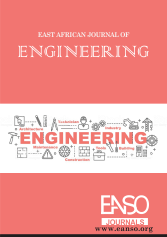Performance of Plastic Waste and Waste Engine Oil as Partial Replacements of Bituminous Asphalt Concrete in Flexible Pavement
Abstract
Plastic waste is an emerging issue posing serious pollution problems to the environment. Waste Engine Oil has also become an environmental nuisance causing water pollution and soil degradation. New effective waste management options need to be considered, especially on recycling concepts. In addition to the emerging environmental issues, the sources of bitumen for road construction are continuously being depleted hence the need for innovative ways of sustaining road construction through the use of plastic waste and waste engine oil. This research project reviewed available literature on the concept of using waste plastic and waste engine oil as partial replacements of bitumen in road construction together while also carrying out the Marshall Stability test in both neat and bituminous mixes modified with plastic waste and waste engine oil. The optimum bitumen content was determined as 6% from the neat samples. Samples of the modified mix were then prepared with the percentage plastic content varying as 10%, 20%, 30%, and 40% of the mass of bitumen. The optimum plastic content was determined at 18% with a stability value of 8580N (an increase from 8337.4N for the neat samples). Samples with both plastic waste and waste engine oil replacements were prepared with 18% plastic waste being replaced with 10%, 20%, 30%, and 40% waste engine oil. The optimum replacement was determined at 19% giving the highest stability of 8820N (an increase of 2.8% from the plastic-only modified mix and an increase of 5.8% from the neat sample). With the utilisation of polymer-modified bituminous mix in highway construction, the pollution and disposal problems of waste plastic may be partly reduced. The use of innovative technology will not only strengthen road construction but also increase road life as well as will help to improve the environment
Downloads
References
Anastasiou, E., Liapis, A., & Papayianni, I. (2015). Comparative life cycle assessment of concrete road pavements using industrial by-products as alternative materials. Resources, Conservation and Recycling, 101, 1-8. https://doi.org/10.1016/j.resconrec.2015.05.009
Costa, L., Peralta, J., Oliveira, J., & Silva, H. (2017). A New Life for Cross-Linked Plastic Waste as Aggregates and Binder Modifier for Asphalt Mixtures. Applied Sciences, 7(6), 603. https://doi.org/10.3390/app7060603
Costa, L., Silva, H., Oliviera, J., & Fernandes, S. (2013). Incorporation of waste plastic in asphalt binders to improve their performance in the pavement. International Journal of Pavement Research and Technology, 457-464.
Deffeyes, K. (2006). Beyond oil. New York: Hill and Wang.
Fuentes-Audén, C., Martínez-Boza, F., Navarro, F., Partal, P., & Gallegos, C. (2007). Formulation of new synthetic binders: Thermo-mechanical properties of recycled polymer/oil blends. Polymer Testing, 26(3), 323-332. https://doi.org/10.1016/j.polymertesting.2006.11.002
Hashmi, S., & Jabary, A. (2020). Introduction of a Sustainable Alternative for Bitumen- Case study of lignin-based asphalt for the Swedish market. Karlstads University MSc. Thesis - Industrial Engineering and Management.
Kenya Ministry of Environment. (2017). The Environmental Management and Co-ordination Act. The Kenya Gazette, March 14: 1077.
Metwally, M., & Williams, R. (2010). Development of Non-Petroleum Based Binders for Use in Flexible Pavements (Final Report). Ames, IA, USA.
Moretti, L., Di Mascio, P., & D'Andrea, A. (2013). Environmental Impact Assessment of Road Asphalt Pavements. Modern Applied Science, 7(11). https://doi.org/10.5539/mas.v7n11p1
Moretti, L., Mandrone, V., D’Andrea, A., & Caro, S. (2017). Comparative “from Cradle to Gate” Life Cycle Assessments of Hot Mix Asphalt (HMA) Materials. Sustainability, 9(3), 400. https://doi.org/10.3390/su9030400
Organisation for Economic Co-operation and Development. (2022). Plastic pollution is growing relentlessly as waste management and recycling fall short, says OECD. Retrieved March 14, 2023, from https://www.oecd.org/environment/plastic-pollution-is-growing-relentlessly-as-waste-management-and-recycling-fall-short.htm
Road Design Manual Part III: Materials & Pavement Design for New Roads. (1987). Ministry of Transport & Communications- Roads Department. The Republic of Kenya.
Takouleu, J. (2019). KENYA: Geocycle wants to eliminate 3 million litres of used engine oil per year | Afrik 21. Afrik 21. Retrieved 22 April 2021, fromhttps://www.afrik21.africa/en/kenya-geocycle-wants-to-eliminate-3-million-litres-ofusedengine-oil-per-year/.
World Highways. (2017). Funding road research in Kenya AS infrastructure development grows. World Highways. Retrieved March 14, 2023, from https://www.worldhighways.com/wh3/wh4/wh6/feature/funding-road-research-kenya-infrastructure-development-grows
Copyright (c) 2023 Joyce Susan Liavuli Ogada, Sixtus Kinyua Mwea, PhD, George Matheri

This work is licensed under a Creative Commons Attribution 4.0 International License.




























